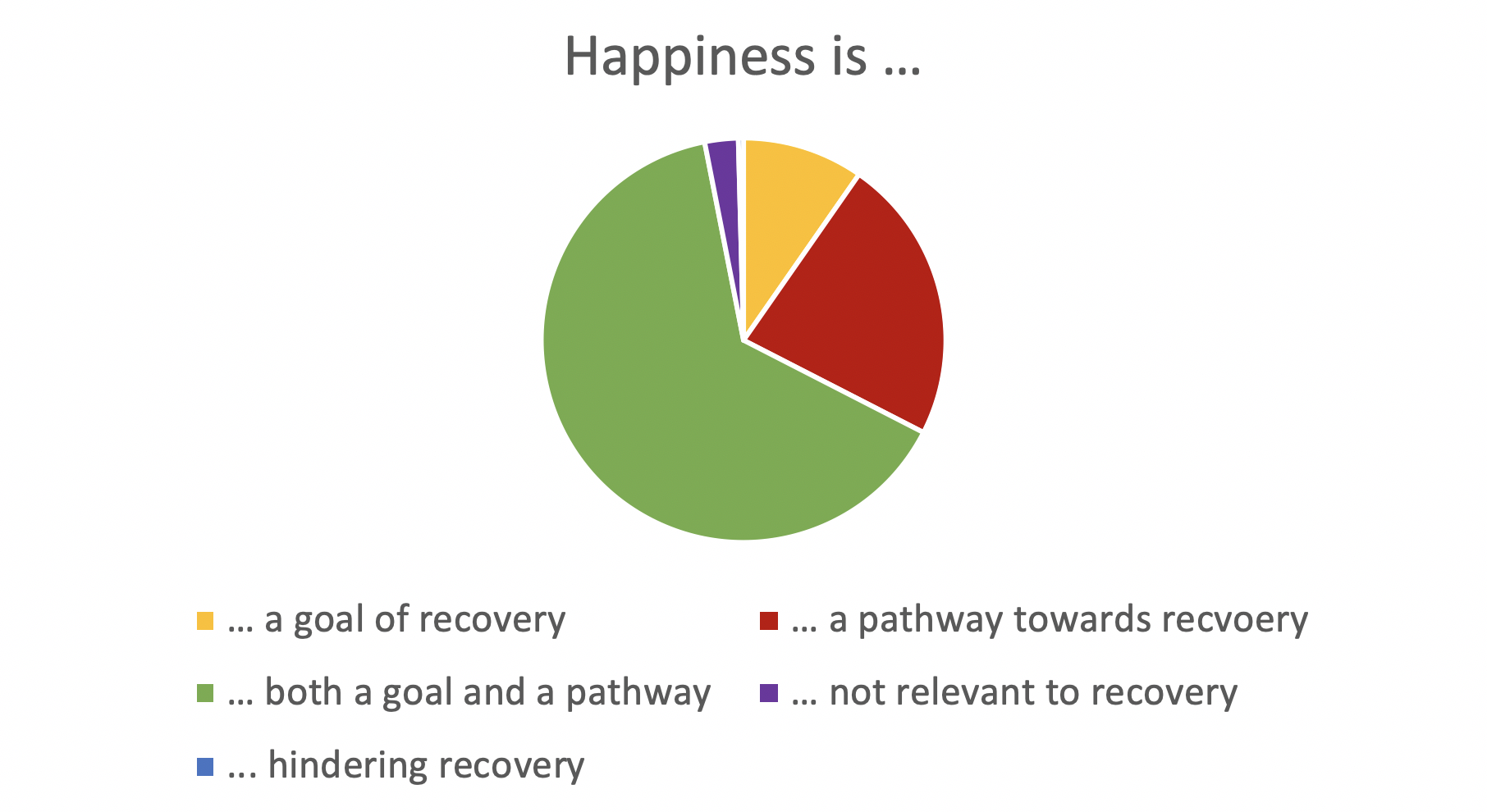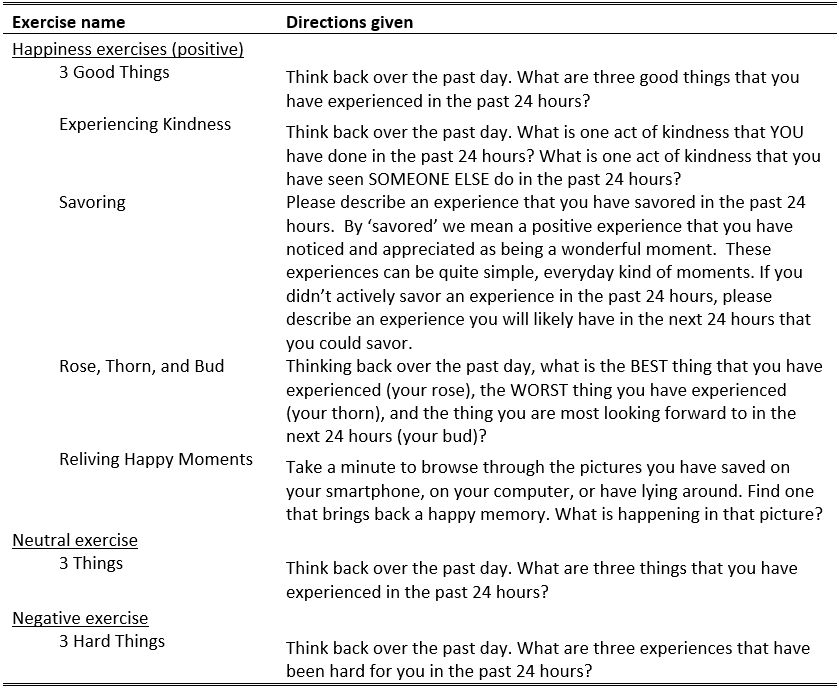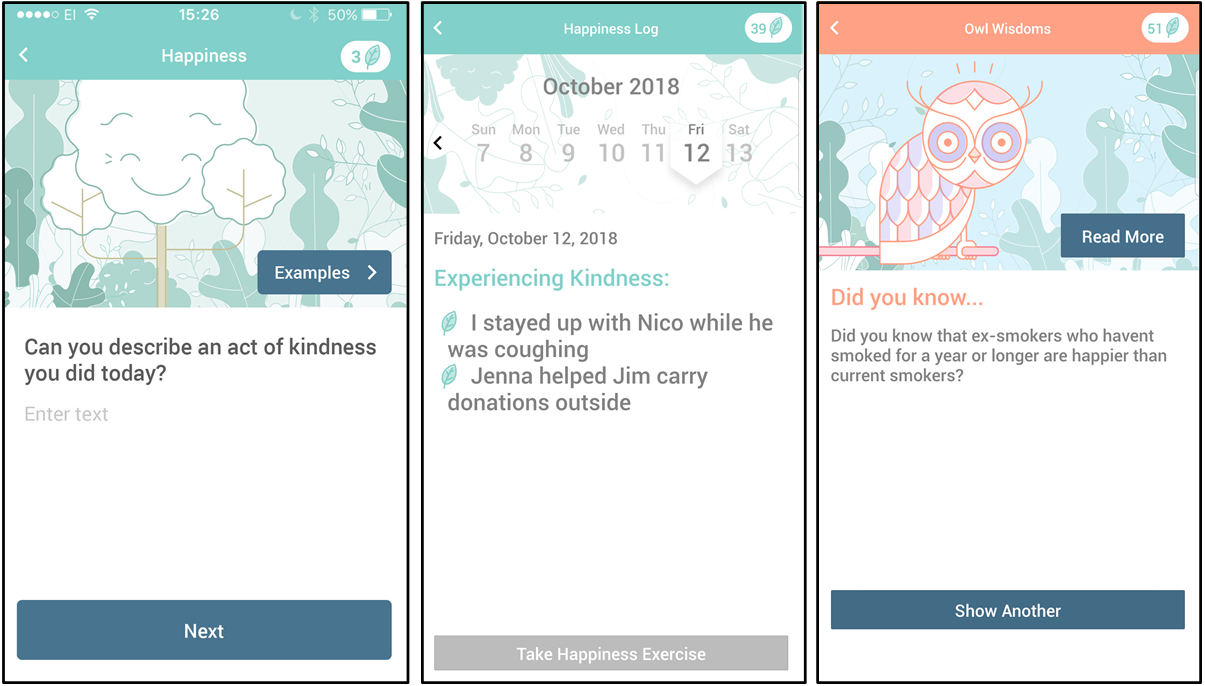Five do-it-yourself exercises to improve how happy you feel right now — do they work?
Happiness matters, or does it? This online, randomized survey study by Recovery Research Institute scientists asked individuals in recovery what they think about the role of happiness in recovery, and tested if brief exercises meant to enhance happiness actually helped them feel happier.
WHAT PROBLEM DOES THIS STUDY ADDRESS?
Positive psychology research, which focuses on understanding and promoting human flourishing, has been conducted for well over two decades. In addiction research, however, “happiness” is not a term that has attracted much research, despite the clear relevance and synergy with the recovery movement (Krentzman, 2013; Resnick & Rosenheck, 2006). Indeed, addiction treatment focuses primarily on identifying and addressing problems, with the idea that in so doing, problems can be resolved, and quality of life is increased. This approach, however, has left relatively little time and energy to focus on enhancing and cultivating positive experiences outright.
It is typically the motivating effects of the negative consequences of substance use that lead to a recovery attempt; yet, this motivational force may weaken over time as someone stabilizes and accrues time in recovery. To help sustain recovery efforts, perhaps a greater focus on, and attainment of, positive experiences would be the more potent motivating force to help people to stay on track. Lots of research points to the potential benefits of the experience of positive emotions – just very little of that research has looked at persons in recovery. To change that, RRI scientist Dr. Bettina Hoeppner and her colleagues conducted an online randomized survey – in fact, with your help, dear readers! – to ask persons in recovery what they think the role of happiness plays in recovery, and then tested if five text-entry based happiness exercises helped them feel happier.
HOW WAS THIS STUDY CONDUCTED?
531 adults describing themselves as seeking or being in recovery from problematic substance use were recruited online from recovery-focused websites to participate in an online survey.
- READ MORE ON STUDY METHODS
-
Participants were asked “What role do you think happiness plays in recovery?” and “How important is your happiness to your recovery process?” Then participants rated their current happiness on a 0-100 scale, completed one of seven (randomly assigned) text-based exercises, and then rated their happiness again. Participants were also asked to rate how easy/hard it was to do the exercise, and if they could do it as part of their daily routine. Additional questions assessed demographics, and other constructs.
 WHAT DID THIS STUDY FIND?
WHAT DID THIS STUDY FIND?
Most participants indicated that happiness was an important part of their pathway of recovery, not just a goal thereof, rating the importance of happiness to the recovery process as 80 on a 0-100 scale.

Figure 1. Participant responses to the question: “What role do you think happiness plays in recovery?”
When randomized to complete either one of five happiness exercises or one of two control exercises (see Table 1), results showed that in-the-moment happiness increased in participants randomized to happiness exercises while it decreased in participants randomized to complete control exercises. The happiness exercises that appeared to work the best (i.e., showed greatest increases in happiness from right before to right after completing the exercise) were “Reliving Happy Moments” (participants browse pictures on their own smartphone, select one picture capturing one of their happy moments, and enter text describing this moment), followed by “Savoring” (participants enter text describing two experiences they savored that day) and “Rose, Thorn, Bud” (participants enter text describing, in turn, the highlight of their day (rose), a challenge of the day (thorn), and something they look forward to tomorrow (bud).

Table 1: The text-entry exercises participants completed.
Notably, the control exercise “3 Hard Things” (participants enter text describing three things that had been hard that day) resulted in the 2nd largest difference in happiness ratings, just in the opposite direction, with participants reporting significantly lower happiness after describing their challenges.
Exercises took on average 4±4 minutes to complete and most participants (93%) felt they could complete them as part of their daily routine.
WHAT ARE THE IMPLICATIONS OF THE STUDY FINDINGS?
The idea of addressing positive emotions in the treatment of addiction is not breathtakingly new. Concepts such as “gratitude”, “hope”, “optimism” and “spirituality” have a long-standing history in overcoming addiction, where the “Gratitude List”, for example, is a fairly common exercise used across social circles of recovery. Yet some of these emotions are pretty complex or even downright controversial. Gratitude, for example, requires some moderately complicated mental gymnastics (i.e., recognizing that something is good, recognizing that someone or something else caused this good thing to happen, and then feeling grateful to that external source – see Dr. Jeff Huffman’s article on gratitude). Spirituality, meanwhile, is experienced very differently by different groups of people, and overt spiritual underpinnings of addiction support can sometimes be experienced as aversive to people.
Thus, looking at positive constructs for inspiration and empowerment of recovery is not a new theme in addiction research. What is new is the idea of actually promoting time spent in enjoyable experiences. Over the past few years, addiction scientists have increasingly argued that it is important to provide greater access to and more time spent in experiences that will be enjoyable or otherwise rewarding to those persons who undertake the challenges of stopping their problematic substance use (McKay, 2017). Yet apart from a handful of pilot studies, little research has addressed which approaches might work.
The results of the Hoeppner study demonstrate that happiness exercises resonate well with a large sample of persons in recovery, who completed the exercises within a reasonable but also thoughtful period of time (approximately 4 minutes). This finding is in line with pilot studies on treatment-receiving adolescents (n=20) (Akhtar & Boniwell, 2010), alcohol use disorder outpatients (n=23)(Krentzman et al., 2015), and methamphetamine-using men who have sex with men (n=21)(Carrico et al., 2015) that have shown that positive psychological interventions are well received by these groups, and can be feasibly implemented. Extending the evidence, the Hoeppner study showed an effect on momentary happiness, that is, on how happy people felt right before vs. right after completing the simple, 4-minute exercises, thereby providing evidence that self-administered, do-it-yourself exercises can have a positive effect on happiness in persons in recovery. Three things in particular had an impact on raising one’s spirits: viewing a personally happy historical moment via a picture on one’s phone, actively savoring positive experiences, and acknowledging that on any given day, positive and challenging experiences co-exist, and that each new day holds promise for positive experiences.
If you’d like to try out a smartphone app that helps you complete these happiness exercises on a daily basis (i.e., an app called “Smiling Instead of Smoking”, see screenshots below), please contact Dr. Bettina Hoeppner (bhoeppner@mgh.harvard.edu).
The app should be ready to download by May 2019, and will be freely available for Android and iPhone devices.

Figure 1. Screenshots from the app “Smiling Instead of Smoking,” which administers daily positive psychology exercises while providing tools to support smoking cessation: (1) a happiness exercise is assigned, (2) its completion is logged, and (3) science findings are shared to reinforce the value of happiness.
- LIMITATIONS
-
The online survey study was done with participants who self-selected into the study, that is, who saw an announcement or ad about a study on happiness, and then decided to participate in it. Thus, it is possible that ratings of the importance of happiness in recovery may be higher in this study than in persons in recovery in general. Note that the evaluation of the effectiveness of these exercises would not be affected by this self-selection bias due to randomization. Also note, however, that over-represented in this sample were female, white, and college-educated participants, which limits the generalizability of the results.
BOTTOM LINE
- For individuals & families seeking recovery: Recovery deals with many challenges. This research highlights five do-it-yourself exercises that could be used to provide a momentary boost in happiness (best effects were found for “Reliving Happy Moments”). Lots of research remains to be done, for example, to see if incorporating these exercises, or exercises like them, into the daily routine would provide long-term benefit. While the jury is still out on the long-term benefit of engaging in happiness exercises over extended periods of time, happiness exercises like these are unlikely to be harmful, and this study provides concrete evidence to suggest that they provide a momentary boost, which on some days may already be a very welcome break!
- For scientists: Positive psychology-based interventions have been implemented in numerous health behavior change settings (e.g., smoking cessation, chronic pain management, cardiovascular disease), and findings in these diverse settings have indicated the appeal and transportability of positive psychology approaches across diverse patient populations. These findings in other fields, combined with pilot findings in the field of addiction, suggest that it may be fruitful to explore how advances made in positive psychology could be leveraged to support recovery from problematic substance use. Particularly needed are randomized trials that test the impact of engaging in happiness exercises (or similar types of exercises) over an extended period of time on downstream behavioral and quality of life indices.
- For policy makers: Quality of life is becoming an increasingly important metric in evaluating recovery outcomes. Apart from simply seeing quality of life as an outcome metric, however, it may be fruitful to consider the attainment of positive experiences as a potentially useful component to augment the care provided by various systems of care. This is a new area of research within addiction, however, and requires much further research, which could greatly benefit from targeted funding opportunities. A particular boon of this approach is that happiness exercises like those tested in this study are highly portable in that they can be self-administered, are easy to understand, and thus can be widely disseminated.
- For treatment professionals and treatment systems: The five exercises described in this paper are simple, do-it-yourself exercises that could be assigned as patient homework (best effects were found for “Reliving Happy Moments”). Note that findings of this study suggest that people with low levels of happiness may require additional coaching and support to motivate them to complete the exercises (in the study, persons with low happiness ratings were less likely to complete the exercises), but findings also showed that if they do complete them, they are as likely to benefit from doing so as persons with initially higher happiness.
CITATIONS
Hoeppner, B. B., Schick, M., Carlon, H., & Hoeppner, S. S. (2019). Do self-administered positive psychology exercises work in persons in recovery from problematic substance use? An online randomized survey. Journal of Substance Abuse Treatment, 99, 16-23.

